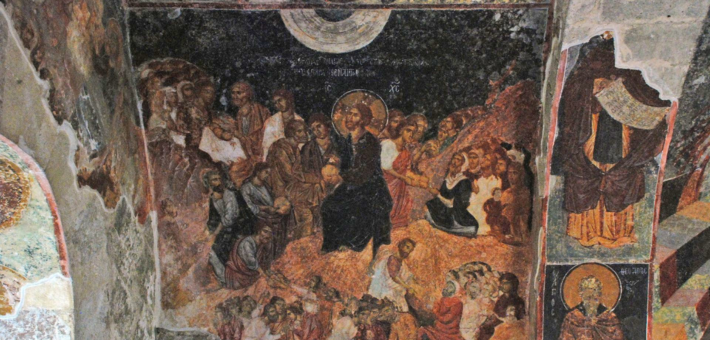Commentary on Matthew 14:13-21
The so-called “Feeding of the Five Thousand” appears in all four Gospels (Matthew 14:13-21; Mark 6:30-44; Luke 9:10-17; John 6:1-14). Matthew’s version both recalls Israel’s exodus from Egypt and foreshadows the Last Supper. Framing the feeding in this way allows the evangelist to draw a parallel between God saving the Israelites from Egyptian slavery and Jesus saving his people from their sins.
Yet, there is irony in the Gospel’s presentation of the feeding in terms of the exodus. Just before Jesus blesses the loaves and fish in front of the hungry multitude, Matthew describes the death of John the Baptist (14:1-12). At the behest of Herod, John had been arrested and beheaded in prison (14:3, 10). Whereas God had worked through Moses and Aaron to free the Hebrews from bondage under Pharaoh, John’s internment and death at the hands of Herod anticipate Jesus’ own judgment and crucifixion under Pilate. John, Jesus, and their fellow Jews never experience the physical liberation that Moses and his people enjoyed.
And still, the Gospel frames the feeding of the five thousand as an “exodus moment” to suggest that Jesus’ presence and power in the lives of his followers is on par with God’s work on behalf of the enslaved Israelites. Specifically, the sustenance that Christ provides is a foretaste of the freedom from sins that he will forecast for his disciples at the Last Supper.
Matthew echoes the exodus in the very first verse of our pericope. After Jesus withdraws to a deserted place, the Gospel notes that the crowds “followed him on foot (pezē)” (Matthew 14:13). According to the Greek translation of Israel’s Scriptures, the first two times that people travel “on foot” are after the Israelites come out of Egypt. Following the first Passover, “the children of Israel journeyed from Rameses to Succoth, about six hundred thousand men on foot (pezē)” (Exodus 12:37, Septuagint). As Israel wanders through the wilderness, Moses addresses God, saying, “The people among whom I am are six hundred thousand on foot (pezē), and you said, ‘Meat I will give them’” (Numbers 11:21 Septuagint). In Matthew, the crowds follow Jesus “on foot” and he feeds them, just as God feeds the pedestrian people after the exodus.
Another reference to the exiting Israelites may exist at the end of our Matthean passage. After Jesus feeds the crowds, the Gospel says that those who ate were “about five thousand men (andres hōsei pentakischīlioi), besides women and children” (Matthew 14:21). Similarly, those who came out of Egypt numbered “about six hundred thousand men (eis exakosīas chiliādas… hōi andres)” (Exodus 12:37, Septuagint). Though the Septuagint follows its number with the phrase “besides the property,” the Hebrew text has “besides the little ones”—which would “logically have to imply or include the women who nurtured them.”¹ Matthew’s addition of “besides women and children” may be a more explicit version of what the Hebrew only infers.
More, Matthew’s inclusion of “women and children” aligns with the Jewish tradition reflected among the evangelist’s contemporaries. The first-century historian Josephus retells the exodus by noting that “the entire multitude of those who went out, including the women and children, was not easy to number, but those who were of an age fit for war were six hundred thousand.”² Similarly, Philo of Alexandria notes that the biblical “six hundred thousand” was the number besides “children and women.”³ Based on this early Jewish understanding of the Exodus account, it is likely that Matthew’s reference to “five thousand men besides women and children” is meant to recall Israel’s escape from Egypt.4
The crowds follow Jesus to a “deserted place” (Matthew 14:13). Matthew reiterates this topography when Jesus’ disciples tell him, “This is a deserted place, and the hour is now late; send the crowds away so that they may go into the villages and buy food for themselves” (14:15). The Greek for “deserted” is erēmos, the same term that the Septuagint uses for the area to which God demands Pharaoh release the enslaved Israelites: “Thus says the Lord, the God of Israel, ‘Send away my people that they may hold a feast to me in the wilderness (erēmos)’” (Exodus 5:1, Septuagint). In the Gospel, Jesus’ followers have come “on foot” to the wilderness already and are about to share a miraculous meal—to follow Christ is to have an “exodus experience.” For Matthew, the feeding of the five thousand recalls the God-ordained goal of exiting Egypt.
Not only does the Gospel evoke the Exodus, but the feeding event also looks forward to the Last Supper. Matthew states that Jesus “took (lambāno) the five [loaves of] bread (artos) and the two fish, and looking up to the heavens, he blessed [it] (eulgēo) and broke [it] (klāo) and gave the bread to his disciples (kai edoken toīs mathetaīs toūs artous), and the disciples [gave it] to the crowds” (Matthew 14:19). Likewise, the night before he was betrayed, “Jesus took bread and after blessing [it] he broke [it] and gave [it] to his disciples” (26:26).
After Jesus refers to this broken bread as “my body” (26:26), he asks his disciples to drink from the cup, saying, “This is my blood of the covenant, which is poured out for many for the release of sins” (26:28). At the feeding of the five thousand, Jesus gives the bread to his disciples, and they give it to the crowds. By repeating this scene at the Last Supper, the Gospel implies that Jesus dies to release the crowds of his followers from their bondage to sin. Matthew’s rendition of the miraculous feeding both recapitulates the exodus and foreshadows the crucifixion to underscore Jesus’ role as the savior of his people.
Notes:
- Robert Alter, The Hebrew Bible, Volume 1: The Five Books of Moses (New York: W. W. Norton, 2019), 263 n. 37.
- Josephus. Antiquities of the Jews. 2.317
- Philo. On the Life of Moses. 1.147
- See W. D. Davies and Dale C. Allison, A Critical and Exegetical Commentary on the Gospel according to Saint Matthew (3 vols.; ICC; London: T&T Clark, 1988-1997), 2.493.


August 6, 2023